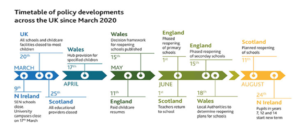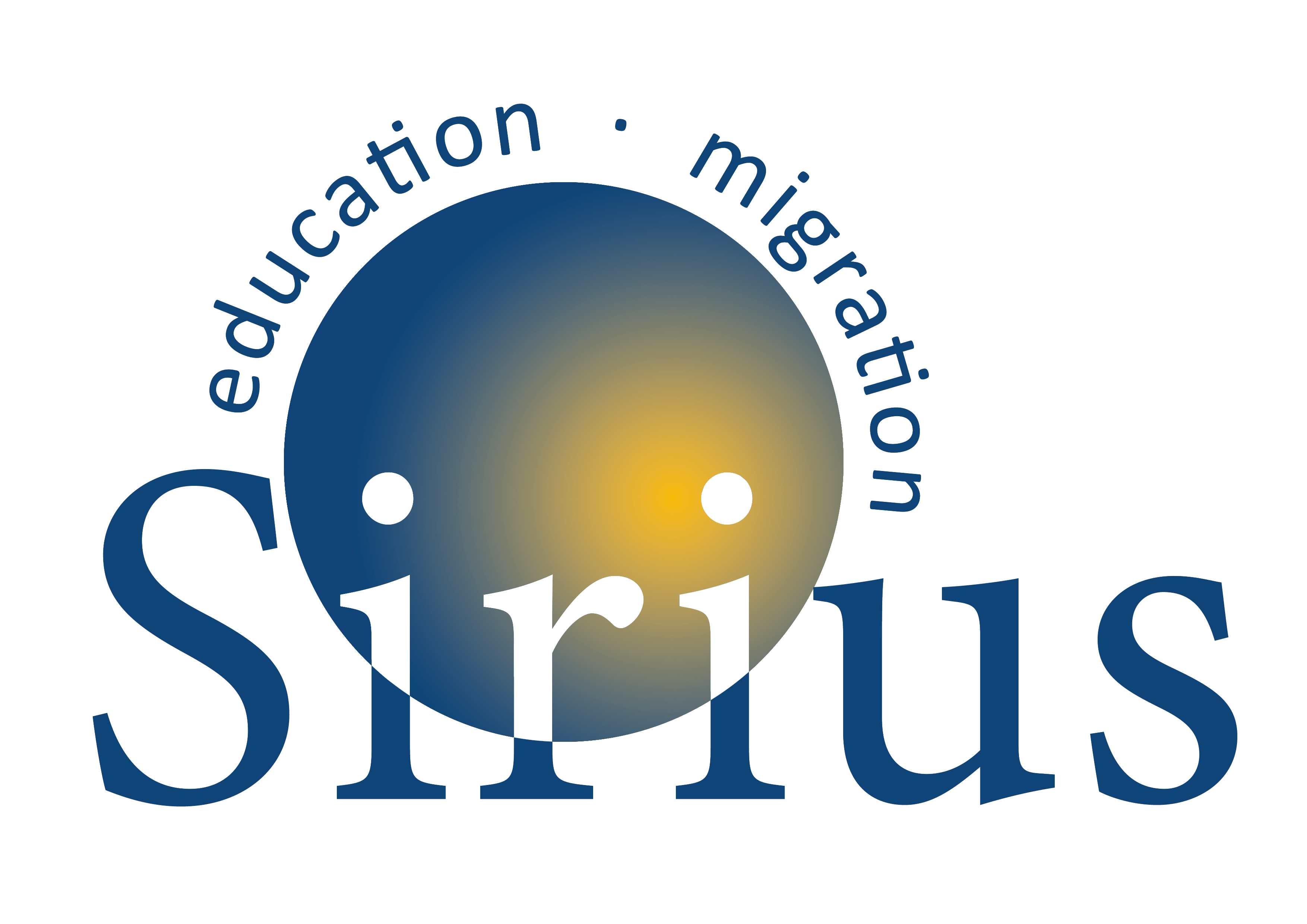Country brief
Country name: United Kingdom
Please estimate the number of children in school (age 3-19) in your country:
8.890.357
Please estimate the number of school drop-outs in your country in the school year 2019/2020:
The number of children missing education or drop-outs is poorly recorded, and available evidence has been described as conflicting and unreliable, due in part to the lack of national monitoring and confusing datasets. Therefore, we are taking the figures and facts on absentees and persistent absentees. A child is defined in law as ‘missing education’ if he/she is not registered at a school; and is not receiving suitable education otherwise than at school.
Headline facts and figures for pupil absence in the autumn term, 2019/20
- Overall absence rate has increased from 4.3% to 4.9%
- Authorised absence has increased from 3.1% to 3.6%
- Unauthorised absence has increased from 1.2% to 1.3%
- Persistent absentees make up13.1% of all enrollments, an increase from 10.9 per cent in Autumn 2018
https://www.gov.uk/government/collections/statistics-pupil-absence
Please estimate the average number of school drop-outs per year in the 5 school years previous to school year 2019/2020?
The release reports on pupils’ absence in primary and secondary schools in the 2019/2020 academic year was cancelled due to the demand for statistics and data to measure the impact of the Covid-19 pandemic.
Absence rates in England between 2014/15 and 2018/19
| 2014/15 | 2015/16 | 2016/17 | 2017/18 | 2018/19 | |
England | Overall absence rate | 4.6% | 4.6% | 4.7% | 4.8% | 4.7% |
Authorised absence rate | 3.5% | 3.4% | 3.4% | 3.5% | 3.3% | |
Unauthorised absence rate | 1.1% | 1.1% | 1.3% | 1.4% | 1.4% | |
Did National exams or evaluation methods take place in academic year 2019/2020? And if so, for which levels?
None
If national exams or evaluation methods did not take place, what is the replacement solution?
Regulators in the UK confirmed that two stages of Standardised Centre Assessment were used:
- Centresand teachers would provide the grade that each learner was most likely to have achieved in each subject if they had sat their exams in 2020. Evidence such as prior work and mock exam results were used to make the judgments. Each school was also required to provide a rank order list of all students for each subject.
- Once submitted to the relevant awarding body, additional statistical data such as acentre’shistorical performance and a cohort’s prior attainment were used to confirm each student’s final grade.
If schools resumed before the summer of 2020, were any particular year groups or other groups identified to have more contact, if so which?
Schools in the state sector across the UK formally closed around the 20th of March, except for children deemed vulnerable by educational providers or local authorities, and children of critical workers. In England and Wales there were ambitions to re-open schools before the summer break, whereas Scotland and Northern Ireland focused on reopening at the end of summer. In England, the phased return of children to school started with the reopening of primary schools on the first of June for learners in the early years, Reception, and Years 1 and 6. The phased re-opening of secondary schools began on 15th June, with schools welcoming up to 25% of students at a time for Years 10 and 12.

When school resumed in the Autumn of 2020, were any particular year groups or other groups identified to have more contact, if so which?
All other pupils returned as normal in September.
Access to education
What were the primary modes of learning implemented during the Covid-19 School closures?
- Online
- Pick-up/Send paper materials
Were the above measures put into place at a policy (national or regional level) or by schools and teachers?
- Policy (national or regional) level
- By schools and teachers
Since pupils have returned to school, a National Tutoring programme has been put in place to support targeted groups (those children and young people who need the most help) alongside the universal catch-up premium.
https://www.gov.uk/guidance/coronavirus-covid-19-catch-up-premium#national-tutoring-programme
Please estimate Number or percentage of children in school (age 3-19) with access to:
- high-speed internet –
- basic internet –
- TV –
- Radio –
- Computer, tablet or smart phone they could use during the day –
In the UK, today’s teenagers have grown up with the Internet and now spend more time online than they do watching television. Almost all 12−15 year olds (98 %) use the Internet; with 96 % accessing it at home via a fixed broadband (BB) connection, and a large proportion also using a mobile network signal.
Three quarters (75%) have accessed the Internet from a computer at home. School access is near universal (92%). Access platforms are diversifying. Most 9-19 year olds (84%) are daily or weekly users of the Internet.
An estimated 95.44% of households own a TV
An estimated 96% of households have Internet access
An estimated 91% of families in the UK have access to a laptop, desktop or tablet at home
https://www.york.ac.uk/res/e-society/projects/1/UKCGOExecSummary.pdf
https://www.ons.gov.uk/peoplepopulationandcommunity/householdcharacteristics/
What translation/interpretation resources/services are/were made available online for students and families from regional or national level?
What special or exceptional learning need supports are/were made available online for students and families from regional or national level?
There was a sector-wide response to supporting schools with adapting to home learning. The Oak National Academy was created in April 2020 as a direct and urgent response to school closures. Over 40 teachers and colleagues from educational organisations joined forces to create an online classroom platform with free video lessons and resources for home learning. Local Authorities in England have also played an important role in providing learning resources (for example, Cambridgeshire in English and Maths or Norfolk County Council’s resources for Early Years to Post-16 learners). Across the UK, teachers have recorded lessons that are freely available on a new online curriculum hub called the Oak National Academy.
Centrally, the government published information, guidance and support for teachers and leaders on educating children during school closures in April 2020. They provided example lessons for teachers on how to conduct lessons remotely. They also offer peer-to-peer advice and training through the EdTech Demonstrator programme to ensure that schools are utilising online platforms and technology to their fullest potential. The Department for Education (DfE) released a list of free online resources in early April, with a focus on subject-specific resources such as for English, Maths, Science and PE. The DfE resources also include links with guidance on maintaining students’ wellbeing. Finally, the DfE has also published and updated guidelines on safeguarding students during remote teaching. This guidance includes advice for schools and parents/carers around ensuring safe online education.
A digital devices scheme was launched in April 2020 by the UK government to provide laptops for disadvantaged children in Year 10. However, there was controversy around the efficacy of the scheme because there were only 200,000 devices available and an estimated 540,000 eligible children in Year 10 were in need of them. Also, figures showed that in June 2020 a third of the devices were yet to be delivered to children who had applied for laptops. A new scheme was developed when children returned to school to deliver laptops to the most disadvantaged pupils, however the budget has been slashed by 80% leading to concerns that educational inequalities will be exacerbated.
The Scottish Government, through the Education Scotland agency, has developed a bank of learning materials that are available on a national basis. These resources include learning activities, weekly newsletters and learning activities for parents/carers, and exemplars of good practice for educators. All teachers, students, and parents/carers in Scotland can also access Glow Connect, which is a National Intranet managed by Education Scotland that allows the users to access learning community communication tools.
In Wales a centralised approach was taken to learning material provision. The Welsh government produced guidance for schools, parents/carers and learners and worked with Universities, Regional Consortia, Colleges, Careers Wales and other organisations to create learning resources. The resources include support for preparation for the next stage of education, subject based resources, and general skills. Teachers and students have access to Hwb, which is the national digital platform for learning and teaching in Wales. Hwb has a range of apps, software, digital tools and resources for use in the classroom and beyond, and many of these resources are bilingual. Additionally, the Children’s Commissioner for Wales provides an information hub for schools, learners and families. There are multiple resources for rights/citizenship education for Primary School teachers including lesson plans which are largely bilingual. The Welsh Government has also published guidance on safeguarding. Recognizing that welfare is of paramount importance, the guidance includes sections on digital work and livestreaming.
They have provided home learning resources for each Key Stage as well as links to external resources. The Northern Ireland Minister of Education has also funded a Bookstart programme in partnership with BookTrust aimed at younger children. It is expected that 24,000 families across Northern Ireland will receive book packs by the end of 2020. The Northern Ireland Department of Education has also created a new ‘Safer Schools’ app which provides safeguarding information, advice and guidance. It also explains safety settings, privacy settings and reporting/blocking functions for social media, apps, games and other platforms, which they hope will assist young people in working safely online.

